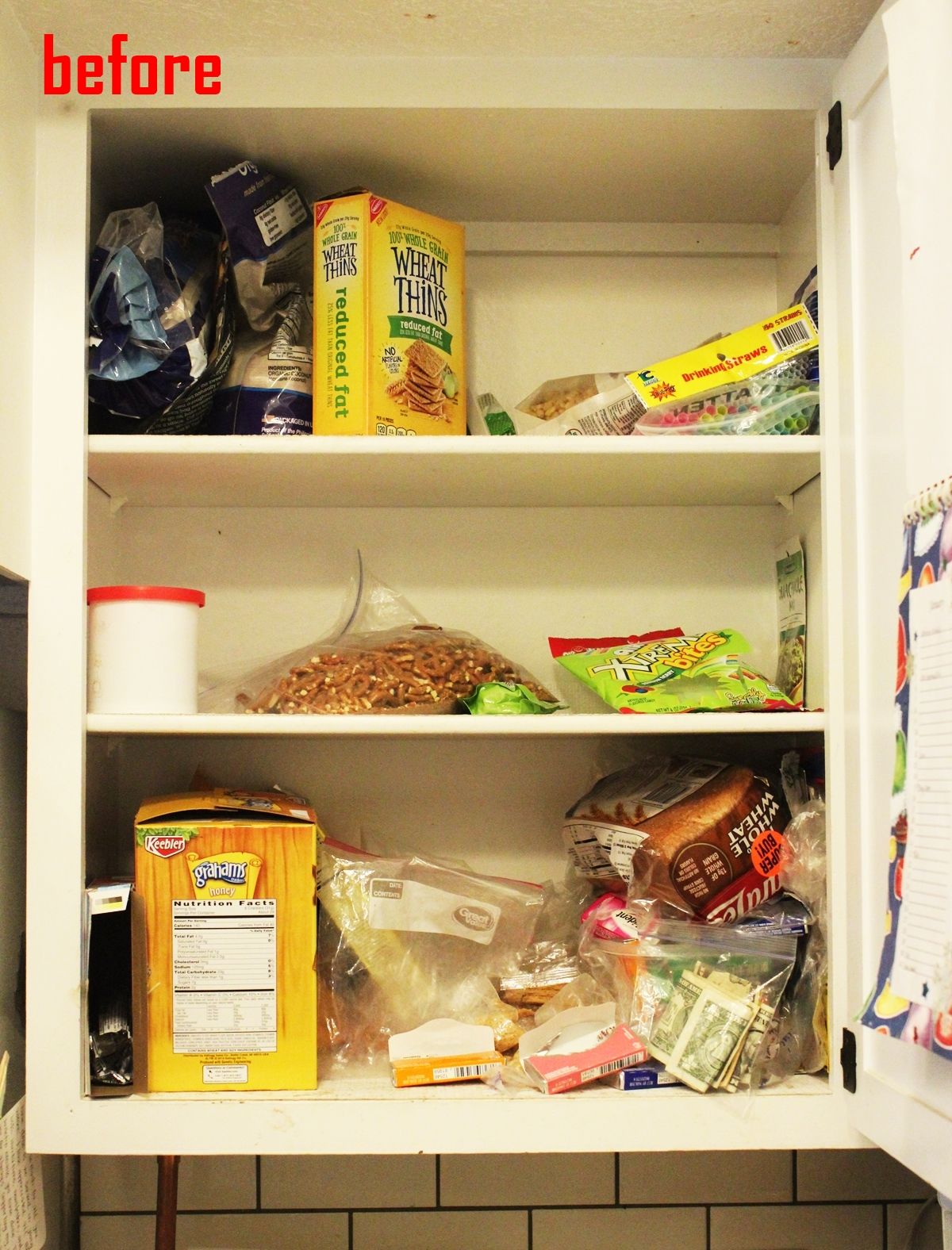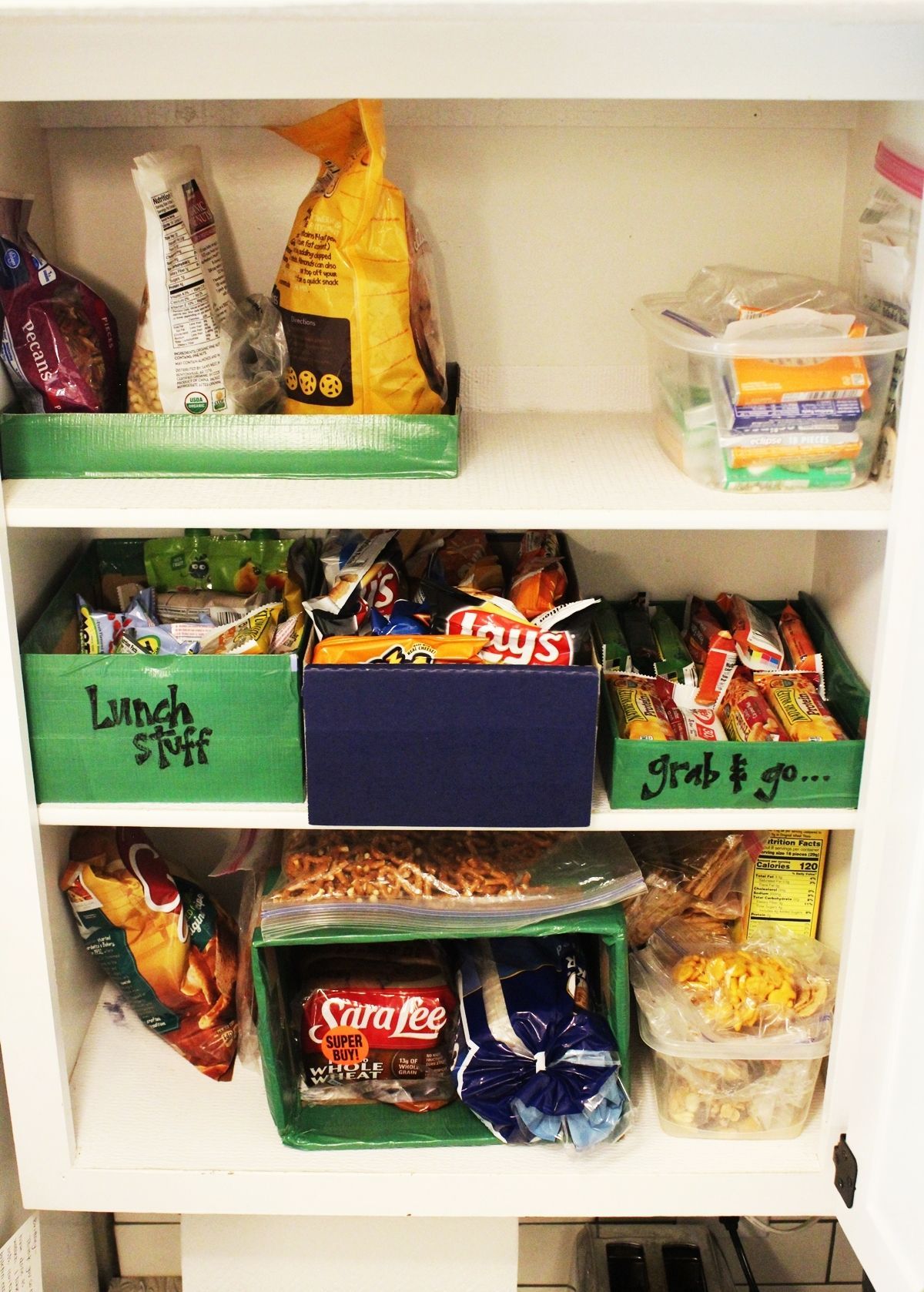There comes a point in probably every kitchen’s existence that requires a significant deep clean. In my experience, the words “declutter” and “deep clean” are practically synonymous, although decluttering is probably more involved because you’re not simply cleaning; rather, you are strategizing and organizing and improving functionality along with cleaning.
I’ll show you how to declutter and organize a cupboard using kitchen cabinet organizers and some time.
How to Organize Kitchen Cabinets:
What You Will Need for kitchen cabinet organizers:
- patience
- time
- garbage bags
- kitchen cabinet organizers (you can also just make some)
- labels
Step One: Pick a Cupboard to Start With
The kitchen cupboard that will be decluttered for this article is this hardest working of cupboards: the keeper of the lunch supplies and the after-school snacks. At least, that’s the cupboard’s intent. You wouldn’t necessarily know it by opening it up and taking a look.
Step Two: Removing Garbage
One obvious thing that requires decluttering is the amassing of plastic storage bags and snacks. A pretzel in a Ziploc here, some graham crackers in a baggie there. The items literally slide down on top of each other, when in reality they shouldn’t even be in the cupboard to begin with.
The easiest and most efficient way to declutter any kitchen cupboard is to empty the entire cupboard out, grouping and tossing items as you go. Consolidate items as appropriate, when you’re working with food. When you’re working with items that require pairs (e.g., bowls and lids), match up those pairings. Basically, you’re sorting through to see what should stay and what should go.
Step Three: Cleaning Your Kitchen Cupboard
With everything out of the cupboard, it’s mandatory that you clean the interior. Vacuum out the particularly crumbly cupboards, and wipe them down with hot, soapy water.
Step Four: Cabinet Organizers
You can buy kitchen cabinet organizers, but I went ahead and made mine for now.
In decluttering, it is not enough simply to declutter. To be successful in your decluttered state moving forward, you have to provide organizational structure so there are appropriate places for everything and easy-to-use storage solutions. In this case, a budget-friendly structure is used: cardboard. Take a large box and cut some cardboard to the depth of your cupboard. It should be as long as the “shelf” you want as well as twice the height.
Score the cardboard at the points where you want it to bend downward (the “legs” of the shelf).
Bend the cardboard along your score lines.
Cut another strip of cardboard with score lines at the same points (or very slightly outside) of your original score lines.
Step Five: Assembling Your DIY Kitchen Cabinet Organizer
Tape the shelf-box together at this point, with the cardboard strip serving as the structure of the larger shelf, holding it in position.
Step Six: Adding More Cabinet Storage
Another cheap solution for kitchen cupboard storage/organization is the most common thing of all: a cardboard shoe box. Find one that fits the depth of your cupboard, or cut one to size. Remove the lid from the shoe box itself.
You can cover the box in wrapping paper or duct tape or wallpaper or contact paper or anything that will make it more attractive, if you wish. Fill it with one of your grouped items.
Step Seven: Label the Boxes
You may also use the lid for containing items as well. Label the boxes so that everyone in your household is aware of what belongs where, and where to find certain things.
Step Eight: Fill and Organize Your Kitchen Cupboard
Replace all the items in your kitchen cupboard that belong there. Remember as you are decluttering in the kitchen, you should pay attention to the position of each cupboard and stock it accordingly. Cupboards near the stove, for example, will hold different items than cupboards near the fridge. Keep baking items together, snack items together, cooking items together, etc. This will make your cooking experiences easier, more efficient, and more enjoyable.
Here’s a brief look at the contents of the boxes. There is much more food in this kitchen cupboard now than in the “before” photo, but it is organized and easily accessible, which means it is a successful decluttering.
For example, nuts (for snacking) may be a choking or allergy hazard for some; these are kept at the top of the cupboard to be out of reach of smaller children. Lunch-making items are boxed and grouped for quick access, which makes the morning chaos much less, well, chaotic.
Gum is also on the top shelf, out of arms of younger children who sometimes confuse gum for silly putty. Grab and go snacks, like granola bars, are labeled and easily reachable for all. All the cracker/bread/bagel/rice cake types of foods are on the bottom shelf, as these items are sometimes needed during breakfast, lunch, and snack time. We hope you enjoy the decluttering and organizing process of your kitchen. It’s very satisfying for the whole family.
Fast Check: Tips for Organizing Kitchens
How to Organize Kitchen Cabinets
- Remove everything
- Get rid of old items and garbage
- Plan ahead. Decide which cabinets are for what items and decide what goes where.
- Make the most of the space using removable shelves, bins, and baskets.
How to Organize Small Kitchen
- Make the most of vertical space
- Get clever and attach baskets under upper cabinets
- Use bins, tins, baskets, and shelving.
- Consider getting a roll-away cart to house more items that you can tuck away when not in use.
The post How to Declutter the Kitchen So It’s More Functional and Easy to Use appeared first on Home Decorating Trends - Homedit.

















0 Commentaires